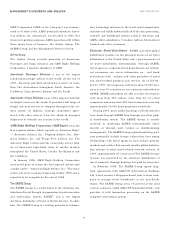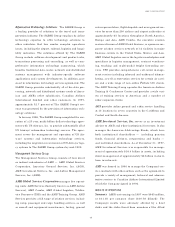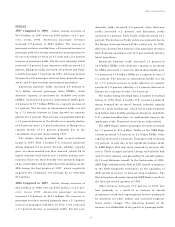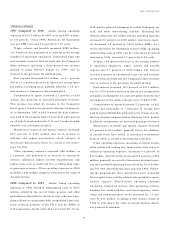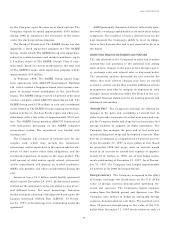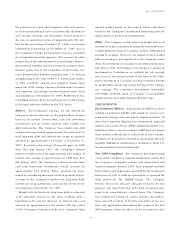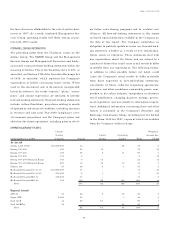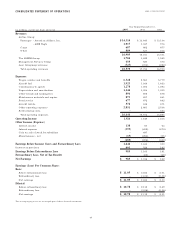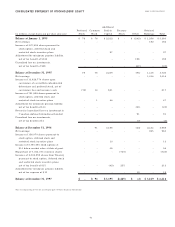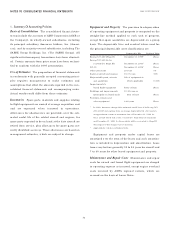American Airlines 1997 Annual Report Download - page 44
Download and view the complete annual report
Please find page 44 of the 1997 American Airlines annual report below. You can navigate through the pages in the report by either clicking on the pages listed below, or by using the keyword search tool below to find specific information within the annual report.
AMR CORPORATION
42
by the Company upon the exercise of stock options. The
Company expects to spend approximately $350 million
during 1998 to repurchase the remainder of the shares
under the stock repurchase program.
The Board of Directors of The SABRE Group has also
approved a stock repurchase program for The SABRE
Group, under which The SABRE Group will repurchase,
subject to certain business and market conditions, up to
1.5 million shares of The SABRE Group’s Class A com-
mon stock. Based on current market prices, the total cost
of The SABRE Group’s stock repurchase program will be
approximately $55 million.
In February 1998, The SABRE Group signed long-
term agreements with ABACUS International Holdings
Ltd. which created a Singapore-based joint venture com-
pany to manage travel distribution in the Asia-Pacific
region. The SABRE Group received 35 percent of the joint
venture company, called ABACUS International Ltd. The
SABRE Group paid $139 million in cash and contributed
assets related to The SABRE Group’s ongoing travel distri-
bution activities in the Asia-Pacific region and other con-
siderations with a fair value of approximately $100 mil-
lion. The SABRE Group provides ABACUS International
with transaction processing on the SABRE computer
reservations system. The investment was funded with
existing cash.
The Company will continue to evaluate uses for any
surplus cash, which may include the retirement,
refinancing, and/or repurchase in the open market or oth-
erwise of debt and/or other fixed obligations, and the
continued repurchase of equity in the open market. The
total amount of debt and/or equity retired, refinanced,
and/or repurchased will depend on market conditions,
AMR’s cash position and other considerations during the
year.
American has a $1.0 billion credit facility agreement
which expires December 19, 2001. At American’s option,
interest on the agreement can be calculated on one of sev-
eral different bases. For most borrowings, American
would anticipate choosing a floating rate based upon the
London Interbank Offered Rate (LIBOR). At Decem-
ber 31, 1997, no borrowings were outstanding under the
agreement.
AMR (principally American Airlines) historically oper-
ates with a working capital deficit as do most other airline
companies. The existence of such a deficit has not in the
past impaired the Company’s ability to meet its obliga-
tions as they become due and is not expected to do so in
the future.
MARKET RISK SENSITIVE INSTRUMENTS AND POSITIONS
The risk inherent in the Company’s market risk sensitive
instruments and positions is the potential loss arising
from adverse changes in the price of fuel, foreign curren-
cy exchange rates and interest rates as discussed below.
The sensitivity analyses presented do not consider the
effects that such adverse changes may have on overall
economic activity nor do they consider additional actions
management may take to mitigate its exposure to such
changes. Actual results may differ. See Note 6 to the con-
solidated financial statements for accounting policies and
additional information.
Aircraft Fuel The Company’s earnings are affected by
changes in the price and availability of aircraft fuel. In
order to provide a measure of control over price and sup-
ply, the Company trades and ships fuel and maintains fuel
storage facilities to support its flight operations. The
Company also manages the price risk of fuel costs pri-
marily utilizing fuel swap and fuel option contracts. Mar-
ket risk is estimated as a hypothetical 10 percent increase
in the December 31, 1997 cost per gallon of fuel. Based
on projected 1998 fuel usage, such an increase would
result in an increase to aircraft fuel expense of approxi-
mately $110 million in 1998, net of fuel hedge instru-
ments outstanding at December 31, 1997. As of Decem-
ber 31, 1997, the Company had hedged approximately
23 percent of its 1998 fuel requirements.
Foreign currency The Company is exposed to the effect
of foreign exchange rate fluctuations on the U.S. dollar
value of foreign currency-denominated operating rev-
enues and expenses. The Company’s largest exposure
comes from the British pound and Japanese yen. The
Company uses options to hedge its anticipated foreign
currency-denominated net cash flows. The result of a uni-
form 10 percent strengthening in the value of the U.S.
dollar from December 31, 1997 levels relative to each of




